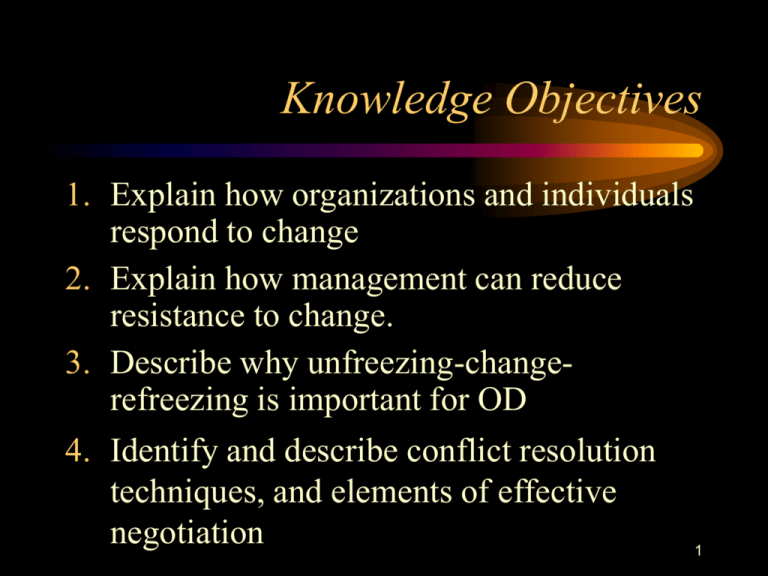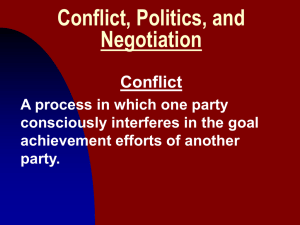Management 9e
advertisement

Knowledge Objectives 1. Explain how organizations and individuals respond to change 2. Explain how management can reduce resistance to change. 3. Describe why unfreezing-changerefreezing is important for OD 4. Identify and describe conflict resolution techniques, and elements of effective negotiation 1 Change: Organizational Perspectives • Types of Organizational Change – Anticipatory changes: planned changes based on expected situations. – Reactive changes: changes made in response to unexpected situations. – Incremental changes: subsystem adjustments required to keep the organization on course. – Strategic changes: altering the overall shape or direction of the organization. 2 Change: Organizational Perspectives (cont’d) • Tuning – The most common, least intense, and least risky type of change - basic routines are unchanged. – Also known as preventive maintenance and kaizen (continuous improvement). – Key is to actively anticipate and avoid problems rather than waiting for something to go wrong. • Adaptation – Incremental changes that are in reaction to external problems, events, or pressures. 3 Change: Organizational Perspectives (cont’d) • Reorientation – Change that is anticipatory and strategic in scope and causes the organization to be significantly redirected. – Also called “frame bending” (Nadler and Tushman). • Re-Creation – Intense and risky decisive change that reinvents the organization. – Also called “frame breaking” (Nadler and Tushman). 4 Individual Reactions to Change • How People Respond to Changes They Like – Three-stage process • Unrealistic optimism • Reality shock • Constructive direction 5 Individual Reactions to Change (cont’d) • How People Respond to Changes They Fear and Dislike – Stages • • • • • Getting off on the wrong track Laughing it off Growing self-doubt Buying in Constructive direction 6 Why Do Employees Resist Change? • Surprise – Unannounced significant changes threaten employees’ sense of balance in the workplace. • Inertia – Employees have a desire to maintain a safe, secure, and predictable status quo. • Misunderstanding and lack of skills – Without introductory or remedial training, change may be perceived negatively. 7 Why Do Employees Resist Change? (cont’d) • Emotional Side Effects – Forced acceptance of change can create a sense of powerlessness, anger, and passive resistance to change. • Lack of Trust – Promises of improvement mean nothing if employees do not trust management. • Fear of Failure – Employees are intimidated by change and doubt their abilities to meet new challenges. 8 Why Do Employees Resist Change? (cont’d) • Personality Conflicts – Managers who are disliked by their managers are poor conduits for change. • Poor Timing – Other events can conspire to create resentment about a particular change. • Lack of Tact – No showing sensitivity to feelings can create resistance to change. 9 Why Do Employees Resist Change? (cont’d) • Threat to Job Status/Security – Employees worry that any change may threaten their job or security. • Breakup of Work Group – Changes can tear apart established on-the-job social relationships. • Competing Commitments – Change can disrupt employees in their pursuit of other goals. 10 Overcoming Resistance to Change • Strategies for Overcoming Resistance to Change – – – – – – Education and communication Participation and involvement Facilitation and support Negotiation and agreement Manipulation and co-optation Explicit and implicit coercion 11 Making Change Happen • Two Approaches to Organization Change – Organization Development (OD) • Formal top-down approach – Grassroots Change • An unofficial and informal bottom-up approach 12 Planned Change Through Organization Development (OD) • Organization development (OD) – Planned change programs intended to help people and organizations function more effectively. – Applying behavioral science principles, methods, and theories to create and cope with change. 13 Planned Change Through Organization Development (OD) (cont’d) • Objectives of OD – Deepen sense of organizational purpose. – Strengthen interpersonal trust. – Encourage problem solving rather than avoidance. – Develop a satisfying work experience. – Supplement formal authority with knowledge and skill-based authority. – Increase personal responsibility for planning and implementing. – Encourage willingness to change. 14 Planned Change Through Organization Development (OD) (cont’d) • The OD Process – Unfreezing, change, refreezing (Kurt Lewin) • Unfreezing: neutralizing resistance by preparing people for change. • Refreezing: systematically following a change program for lasting results. 15 Unofficial and Informal Grassroots Change • Tempered Radicals – People who quietly try to change the dominant organizational culture in line with their convictions. – Guidelines for tempered radicals • • • • Think small for big results. Be authentic. Translate. Don’t go it alone. 16 Managing Conflict • Dealing with the Two Faces of Conflict – Competitive conflict: parties are pursuing directly opposite (win-lose) goals. – Cooperative conflict: a mutually reinforcing experience (win-win) that serves the best interests of both parties. • Conflict Triggers – Conflict trigger: any factor that increases the chances of conflict. 17 Managing Conflict (cont’d) • Types of Conflict Triggers (cont’d) – – – – – Ambiguous or overlapping jurisdictions. Competition for scarce resources. Communication breakdowns. Time pressure. Unreasonable standards, rule, policies, or procedures. – Personality clashes. – Status differentials. – Unrealized expectations. 18 Managing Conflict (cont’d) • Resolving Conflict: Conflict Resolution Techniques – – – – – Problem solving Superordinate goals Compromise Forcing Smoothing 19 Organizational Politics • What Does Organizational Politics Involve? – The pursuit of self-interest at work in the face of real or imagined opposition. • Effects of Organizational Politics – Hinders organizational and individual effectiveness. – Is an irritant to employees. – Can have significant ethical implications. 20 Organizational Politics (cont’d) • Research on Organizational Politics – The perception that the higher the level of management, the greater amount of politics. – The larger the organization, the greater the politics. – Staff personnel are more political than line managers. – Marketing people are the most political; production people were considered the least political. – 61% of employees believed organizational politics helps advance one’s career. – 45% of employees believed that organizational politics detracts from organizational goals. 21 Organizational Politics (cont’d) • Political Tactics – Posturing: “One upmanship” and taking credit for others work. – Empire building: gaining control over human and material resources. – Making the supervisor look good: engaging in “apple polishing.” – Collecting and using social IOUs: exchanging reciprocal political favors by making someone 22 look good or covering up their mistakes. Organizational Politics (cont’d) • Political Tactics – Creating power and loyalty cliques: facing superiors as a cohesive group rather than alone. – Engaging in destructive competition: sabotaging the work of others through character assassination. 23 Organizational Politics (cont’d) • Antidotes to Political Behavior – Strive for a climate of openness and trust. – Measure performance results rather than personalities. – Encourage top management to refrain from political behaviors. – Strive to integrate individual and organizational goals through meaningful work and career planning. – Practice job rotation to encourage broader perspectives and understanding of the problems of others. 24 Negotiating • Negotiation – A decision-making process among interdependent parties with different preferences. • Common Types of Negotiation – Two-party negotiation (e.g., buyer and seller) – Third party negotiation (e.g., agents and arbitrators) 25 Negotiating (cont’d) • Elements of Negotiation – Adopting a win-win attitude • Understanding that mutual beneficial agreement addresses the both parties’ interests. – Knowing your BTNA (best alternative to a negotiated agreement) • Your “bottom line” for accepting or rejecting offers. – Identifying the Bargaining Zone • Negotiation is useless if both parties involved have no common ground on which to maneuver during bargaining. 26 Negotiating (cont’d) • Added Value Negotiating (AVN) – A practical five-step win-win process involving development of multiple deals. • Clarify subjective and objective interests; seeking common ground. • Identify options and their marketplace values. • Design alternative deal packages that foster a creative agreement. • Select a mutually acceptable deal that is most feasible for both parties. • Perfect the deal by hammering out unresolved details. 27








